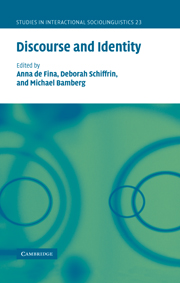Book contents
- Frontmatter
- Contents
- List of contributors
- Introduction
- Part I Overview: theory, method and analysis
- Part II Private and public identities: constructing who we are
- Editors' introduction
- 5 Identity à la carte: you are what you eat
- 6 Workplace narratives, professional identity and relational practice
- 7 Identity and personal/institutional relations: people and tragedy in a health insurance customer service
- 8 The discursive construction of teacher identities in a research interview
- 9 Becoming a mother after DES: intensive mothering in spite of it all
- Part III The gendered self: becoming and being a man
- Part IV The in-between self: negotiating person and place
- References
- index
9 - Becoming a mother after DES: intensive mothering in spite of it all
Published online by Cambridge University Press: 09 November 2009
- Frontmatter
- Contents
- List of contributors
- Introduction
- Part I Overview: theory, method and analysis
- Part II Private and public identities: constructing who we are
- Editors' introduction
- 5 Identity à la carte: you are what you eat
- 6 Workplace narratives, professional identity and relational practice
- 7 Identity and personal/institutional relations: people and tragedy in a health insurance customer service
- 8 The discursive construction of teacher identities in a research interview
- 9 Becoming a mother after DES: intensive mothering in spite of it all
- Part III The gendered self: becoming and being a man
- Part IV The in-between self: negotiating person and place
- References
- index
Summary
You know, I think I'd been thro- through so much with my daughter um, that it just really, the things that happened to me like you could probably throw darts at me and it really wouldn't bother me.
(Hannah Fisher, a DES daughter)Introduction
For most of the twentieth century, the dominant North American view of mothering was that one woman – the biological mother – should take almost exclusive responsibility for taking care of children during their formative years, and conversely that children need “constant care and attention from one caretaker, their biological mother” (Glenn 1994: 3). This view is called “the ideology of intensive mothering” by Sharon Hays (1996). It “declares that mothering is exclusive, wholly child centered, emotionally involving, and time-consuming. The mother portrayed in this ideology is devoted to the care of others” and self-sacrificing (Arendell 2000: 1194). An intensive mother is held and holds herself accountable for keeping her children fed and housed and “for shaping the kinds of adults these children will become” (Hays 1996: 108). Intensive mothering ideology is dominated by and exhibits a logic of family and private life that requires a moral commitment to “relationships grounded in affection and mutual obligations” (Hays 1996: 152). Among other things, intensive mothering ideology assumes a seamless progression from conception to birth. However, some women's abilities to manage this trajectory is fragile and unpredictable; an easy pregnancy followed by the birth of a healthy infant cannot always be assumed.
- Type
- Chapter
- Information
- Discourse and Identity , pp. 233 - 252Publisher: Cambridge University PressPrint publication year: 2006
- 8
- Cited by



